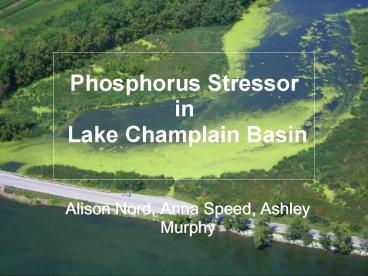Phosphorus Stressor in Lake Champlain Basin - PowerPoint PPT Presentation
1 / 21
Title:
Phosphorus Stressor in Lake Champlain Basin
Description:
Phosphorus Stressor in Lake Champlain Basin Alison Nord, Anna Speed, Ashley Murphy Classifying types of Phosphorus The 1993 Water Quality Agreement established in ... – PowerPoint PPT presentation
Number of Views:119
Avg rating:3.0/5.0
Title: Phosphorus Stressor in Lake Champlain Basin
1
Phosphorus Stressor in Lake Champlain Basin
- Alison Nord, Anna Speed, Ashley Murphy
2
Classifying types of Phosphorus
- The 1993 Water Quality Agreement established
in-lake total phosphorus concentration goals
ranging from 0.010-0.025 mg/l for 13 segments of
Lake Champlain
3
Phosphorus concentrations criteria for various
Lake segments
Missisquoi Bay (0.025)
Isle LaMotte (0.014)
St. Albans Bay (0.017)
Cumberland Bay (0.014)
Northeast Arm (0.014)
- LCBP recommended a 0.010 mg/L phosphorus
criterion in the Main Lake and Malletts
Bay segments - For the rest of the lake (except for St. Albans
Bay, Missisquoi Bay, and the South Lake), an
alternative phosphorus criterion of 0.014 mg/L
was suggested - Missisquoi Bay and the South Lake segments
phosphorus criterion of 0.025 mg/l (naturally
eutrophic)
Malletts Bay (0.010)
Burlington Bay (0.014)
Main Lake (0.010)
Shelburne Bay (0.014)
Otter Creek (0.014)
Port Henry (0.014)
South Lake A (0.025)
South Lake B (0.054)
4
SourcesW/ Rankings
- Non-Point Sources
- Agricultural land (4)
- Urban (4)
- Point sources
- Waste Water treatment plants (1)
- Fisheries (.5)
- Industry (?)
5
Non-Point Sources
- Non point sources runoff from roads and
developed areas, lawns, farmlands, and other
rural areas - Runoff from non-point sources contribute to more
than 90 of the phosphorus in Lake Champlain
6
Agriculture
- Rank 4 in effects filter
- Agriculture 14 of the Basins land area
- contributes about 38 of the total nonpoint
source phosphorus load to the Lake - Major sources of agricultural phosphorus
7
Urban
- Rank 4 in the effects filter
- Urban and suburban land contribute up to 4x the
phosphorus per unit area than either agricultural
or forested land - Urban land constitutes 5 of the land use, yet it
is estimated to contribute about 46 of the total
phosphorus! - 46 of nonpoint source phosphorus load is from
urban land uses
8
(No Transcript)
9
Point Sources of Phosphorus
- Point Sources are wastewater treatment plants and
industrial discharges - Due to reduction efforts, less than 10 of the
phosphorus in the Lake comes from point sources
10
Wastewater Treatment Plants
- Rank 1
- In general, maintained WWTP
- Since 1996, over 28 million has been spent in
the Lake Champlain Basin to upgrade phosphorus
removal technologies at wastewater treatment
plants.
11
(No Transcript)
12
Fisheries
- Rank 0.5
- has some effect, but not extremely important
- Little literature found regarding fisheries and
input of phosphorus into lake
13
Industry
- Not sure what is included in industry - WWTP and
Fisheries already counted for - Other industries could be paper mills...
14
Discussion on Sources
- Matrix/Effects filter
- How do we show that, while Ag and Urban are
critical (4), urban has more of an impact per
area? - LCBP considers roads under urban sources all
data sets include roads under urban so it will be
difficult to differentiate - Need to weigh non-point more than point
- Would like to have data of watersheds broken down
by land use - How do we incorporate land use differences?
- Much less urban land, but huge impact
15
Habitats
- Lake Champlain
- lt6 - algal blooms occur
- gt6 - diluted enough that dont see big impacts?
- Lakes/Ponds other than Lake Champlain
- Rivers/Streams
- Wetlands
16
Lake Champlain
- High impact by phosphorus
- Phosphorus encourages blue-green algae growth
- Some types of blue-green algae contain natural
toxins that are released when these algae die and
break down - Toxins are then released into the water creating
a health concern - Bacteria consume dissolved oxygen and kill off
zooplankton, altering the food chain and
eventually killing off fish species - Recreation ceased during blue-green algae blooms
17
Rivers/Streams
- High impact by phosphorus
- Non-point sources account for 76 of the total
phosphorus load to watershed streams - Surface erosion contributes to increased
phosphorus loading into streams - Change in stream channels increased stream bank
erosion - Phosphorus in surface run off from agricultural
fields 41 of total load to streams in St.
Albans
18
Lakes/Ponds
- Medium impact by phosphorus
- Examples Mirror Lake, Lake George, Saranac Lake
- In general, water consists of 7 of land cover
within the basin - Lakes contribute greatly to tourism, recreation,
and as a water source for residents
19
Wetlands
- Rank 0.5
- Consume P, act as sink - but very dependent upon
vegetation type, water flow - Can release phosphorus during storm events if too
much phosphorus enters wetland
20
Discussion on Habitats
- Several of the habitats are also sources of
phosphorus - For our purposes, only considered habitats where
phosphorus did not originate - Need more work on Impacts filter
21
Questions? Comments?































